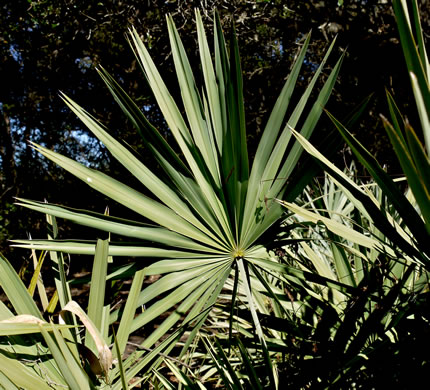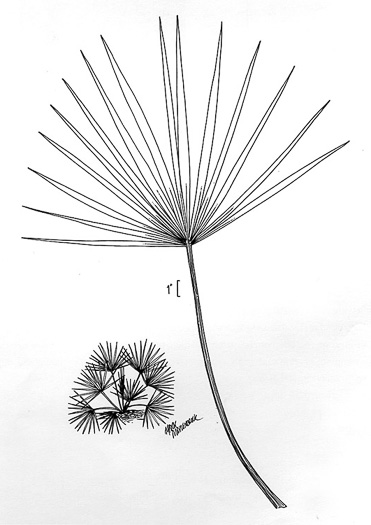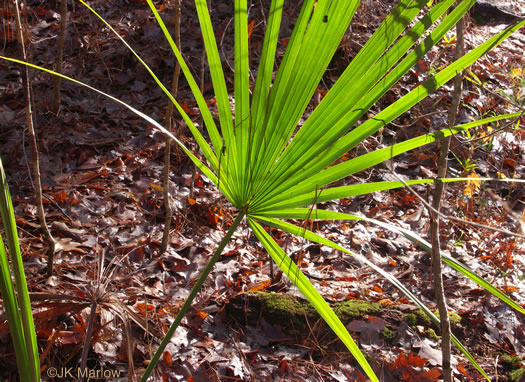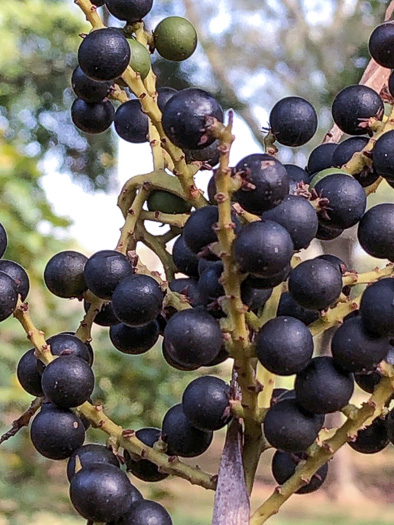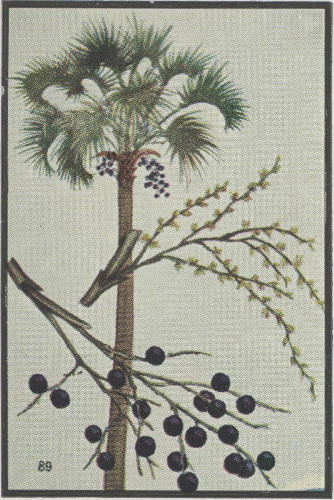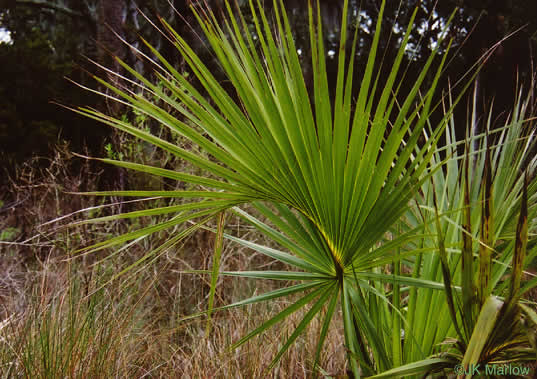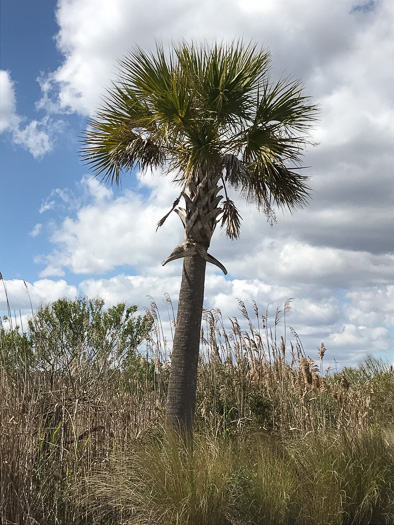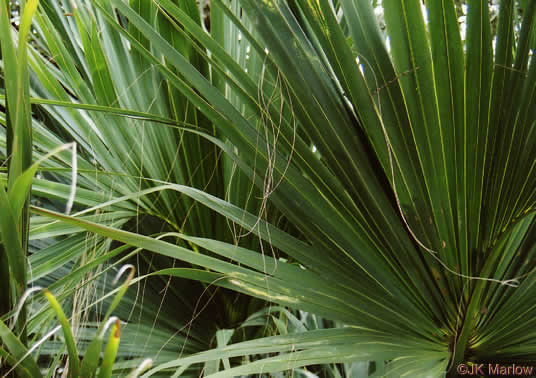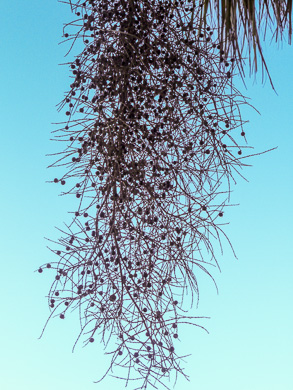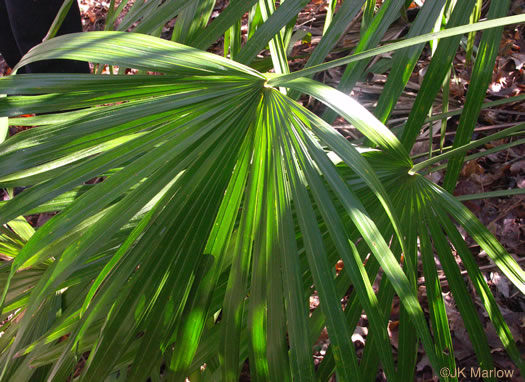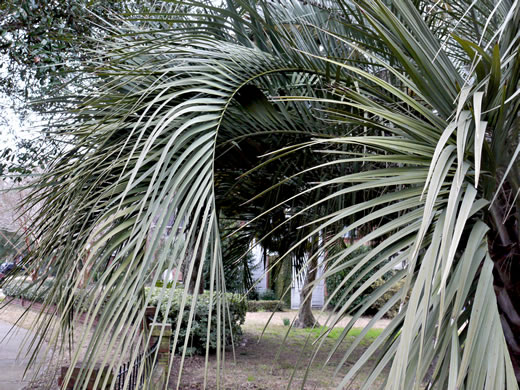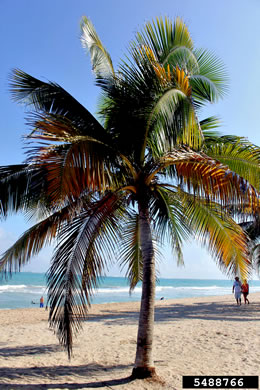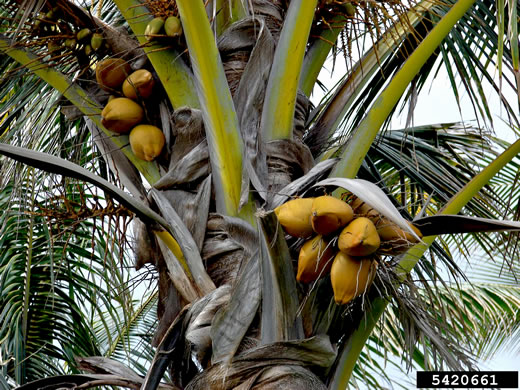Hovering over an image will enlarge it and point out features (works better on desktop than on mobile).
![]() A camera indicates there are pictures.
A camera indicates there are pictures.
![]() A speaker indicates that a botanical name is pronounced.
A speaker indicates that a botanical name is pronounced.
![]() A plus sign after a Latin name indicates that the species is further divided into varieties or subspecies.
A plus sign after a Latin name indicates that the species is further divided into varieties or subspecies.
Most habitat and range descriptions were obtained from Weakley's Flora.
Your search found 6 taxa in the family Arecaceae, Palm family, as understood by Vascular Flora of the Carolinas.

![]()
![]() Common Name:
Saw Palmetto
Common Name:
Saw Palmetto
Weakley's Flora: (4/24/22) Serenoa repens FAMILY: Arecaceae
SYNONYMOUS WITH PLANTS National Database: Serenoa repens FAMILY: Arecaceae
SYNONYMOUS WITH Vascular Flora of the Carolinas (Radford, Ahles, & Bell, 1968): Serenoa repens 031-01-001 FAMILY: Arecaceae
Habitat: Pine flatwoods, maritime forests, dunes, pine rocklands, and Florida dry prairie, xeric longleaf pine sandhills, scrubby pine flatwoods, and Florida scrub. Also used horticulturally, especially the gray (blue) forms
Common in GA Coastal Plain (rare in SC)
Native to South Carolina & Georgia

![]()
![]() Common Name:
Dwarf Palmetto, Bush Palmetto, Dwarf Blue Palmetto, Bluestem Palmetto
Common Name:
Dwarf Palmetto, Bush Palmetto, Dwarf Blue Palmetto, Bluestem Palmetto
Weakley's Flora: (4/14/23) Sabal minor FAMILY: Arecaceae
SYNONYMOUS WITH PLANTS National Database: Sabal minor FAMILY: Arecaceae
SYNONYMOUS WITH Vascular Flora of the Carolinas (Radford, Ahles, & Bell, 1968): Sabal minor 031-02-001 FAMILY: Arecaceae
Habitat: Swamps, maritime forests, low moist woods, especially in calcareous soils developed from shell limestone (marl), hardwood flatwoods, marshes, saline barrens, also rarely planted as an ornamental farther inland, where persisting (and appearing native) or possibly naturalizing
Common in Coastal Plain (rare in Piedmont)
Native to the Coastal Plain of the Carolinas & Georgia, and the GA Piedmont

![]()
![]() Common Name:
Cabbage Palmetto
Common Name:
Cabbage Palmetto
Weakley's Flora: (4/24/22) Sabal palmetto FAMILY: Arecaceae
SYNONYMOUS WITH PLANTS National Database: Sabal palmetto FAMILY: Arecaceae
SYNONYMOUS WITH Vascular Flora of the Carolinas (Radford, Ahles, & Bell, 1968): Sabal palmetto 031-02-002 FAMILY: Arecaceae
Habitat: Maritime forests, marsh edges, and other near-coastal communities
Common in Coastal Plain (rare in NC)
Native to the Carolinas & Georgia

![]()
![]() Common Name:
Needle Palm, Blue Palmetto
Common Name:
Needle Palm, Blue Palmetto
Weakley's Flora: (4/24/22) Rhapidophyllum hystrix FAMILY: Arecaceae
SYNONYMOUS WITH PLANTS National Database: Rhapidophyllum hystrix FAMILY: Arecaceae
Habitat: Moist to wet soils of small blackwater stream swamps, especially where underlain with coquina limestone ("marl"), hydric hammocks and rich, wetland-upland transitions
Common in GA Coastal Plain (rare elsewhere in GA & SC)
Native to South Carolina & Georgia

![]() Common Name:
Pindo Palm, South American Jelly Palm, Brazilian Butia
Common Name:
Pindo Palm, South American Jelly Palm, Brazilian Butia
Weakley's Flora: (4/14/23) Butia odorata FAMILY: Arecaceae
INCLUDED WITHIN (MISAPPLIED) PLANTS National Database: Butia capitata FAMILY: Arecaceae
Habitat: Widely planted in the outer Coastal Plain of se. NC, e. SC, e. GA, and FL, persistent in apparently semi-natural situations, and now showing signs of establishing and spreading from seed into natural areas
Rare
Non-native: southern Brazil & Uruguay

![]() Common Name:
Coconut Palm
Common Name:
Coconut Palm
Weakley's Flora: (4/24/22) Cocos nucifera FAMILY: Arecaceae
SYNONYMOUS WITH PLANTS National Database: Cocos nucifera FAMILY: Arecaceae
Habitat: Beaches, disturbed areas
Waif(s)
Non-native: Paleotropics
Your search found 6 taxa. You are on page PAGE 1 out of 1 pages.


